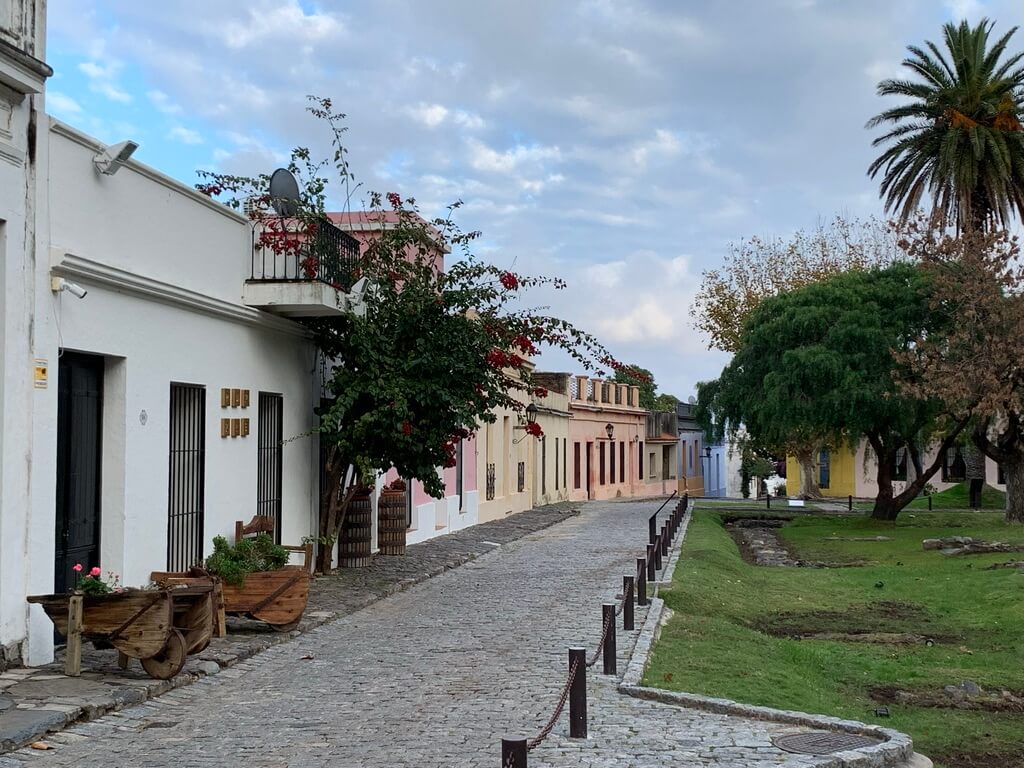Did you know that the easiest way to get from Montevideo, Uruguay to Buenos Aires, Argentina is by boat? All you have to do is board a bus at Montevideo’s Tres Cruces Terminal, which will then drop you off in the small town of Colonia del Sacramento. From there, the ferry to Buenos Aires is a short walk and a trip through passport control away.
If you’re staying near Ciudad Vieja or other areas of central Montevideo, it’s a quick Uber or taxi ride from your lodgings to Montevideo’s Tres Cruces Terminal. From there, it’s very straightforward to board the bus to Colonia. Once you arrive in Colonia, walk around as much as you can before boarding the ferry to Buenos Aires, as it’s a beautiful area.
While this was a fairly seamless process in practice, it’s not particularly straightforward when you’re first booking it, so here are some tips to ensure you aren’t stressed the day of!
- Book your ferry trip way ahead of time. These fill up quickly and you don’t want to run the risk of not being able to leave when you want to. Buquebus seems to release tickets about 5 months in advance from what we’ve experienced. Definitely try to do this at least 2 weeks in advance in order to secure economy seats.
- There are 3 options for ferries, with a variety of add-ons, like tours of Colonia: Buquebus, Sea-Cat, and Colonia Express. We opted to go for Buquebus, as it was the only company with regular winter departures. It seemed to us that Buquebus was the most popular option in general, but it merits exploring all three to see which best fits your needs and budget. If you’re bringing a car, the ferries have space for them.
- If you decide to go with Buquebus, like we did, you can get started at the Buquebus website or book directly via a service provider like DirectFerries, who we often use.
- Select “Solo Ida” if you are doing a 1-way from Montevideo to Buenos Aires, and select how many tickets you need. Make sure your fare includes the bus transfer from Montevideo to Colonia. Each bus+ferry transfer should cost about $40-50 USD per person for the economy tickets. Buquebus does offer a direct ferry from Montevideo to Buenos Aires, but it is more expensive and you don’t get to see Colonia, which is a lovely place to stop!
- Don’t get stressed when you see conflicting information and complaints about the Buquebus administration, etc. This is a really reliable service that does several border crossings each day, and is the best way to get to Argentina from Uruguay. We got rather stressed and nervous and ultimately everything went swimmingly.
- The only hiccup we had while booking was that Buquebus did not accept the first two (American) credit cards we tried to use. This was frustrating because we had to start over each time, but ultimately it did accept a card. If you only have one card and it isn’t accepted, reach out via this form or social media (Twitter, Facebook) to the Buquebus administration, where their response times are much faster than the phone.
- We chose the 6:45 bus + 10AM ferry combination, arriving in Buenos Aires at 11:15AM. Note: If we could go back, we would’ve chosen the next available time slot.
- Though it was great to arrive in Buenos Aires early in the day, we didn’t have nearly enough time to explore Colonia, which is a lovely area with beautiful colonial architecture and cobbled streets, right across the Rio del la Plata from Buenos Aires.
- We did a quick loop around, but were very crunched for time, especially because the line for passport control prior to boarding the ferry does get quite long and they recommend that you get in line two hours prior, similar to an airport.
- Note that your ticket includes 1 piece of luggage, scanned in an airport-style scanner.
- Though it may not feel like it, you’re crossing an international border. Make sure your passport and paperwork are in order when you get in line, and make sure you get in line early. The border patrol takes boarding the ferry just as seriously as any other border crossing, and the best seats on the ferry are first-come-first serve. The sooner you get on the boat, the better views you’ll have. Again, they recommend that you get in line two hours in advance.
- Once you arrive in Buenos Aires, you’ll be dropped off in the Puerto Madero area. This is a fantastic area to explore, but was heavily under construction when we visited and as a result had a lot of detours and heavy traffic around it. Depending on where you’re staying in Buenos Aires, you may want to drop off your things and make your way back to this area later in your visit. We took an Uber to our Airbnb in the Palermo area from here.
DirectFerries booking widget

If you’re planning a trip to Argentina, click around for our guides to Buenos Aires and the Argentine Patagonia! For Chile guides, check out our guides to Santiago, Valparaiso, and the Atacama Desert.
Let us know your thoughts in the comments! Did you try mate? How was your Buquebus experience?
